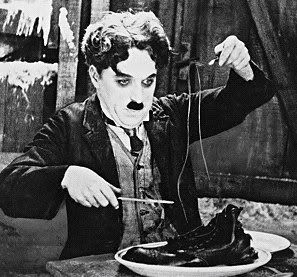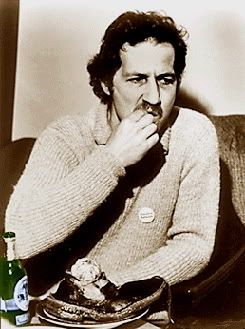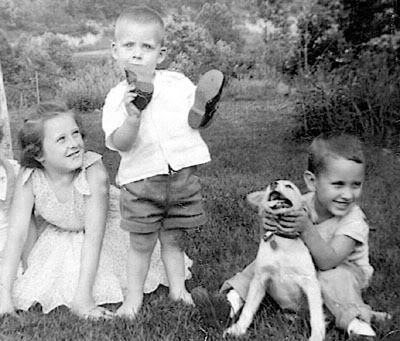A History of Pedilophagia in the Cinema
Pedilophagia being the consumption of shoes.
The first known instance of pedilophagy occurs in Charlie Chaplin's The Gold Rush, when the starving Little Tramp must eat his own boots in order to survive. Shoe-eating in this instance serves a narrative purpose and functions as comedy. The humorousness of the situation comes from the delicacy with which the Tramp eats the shoe, treating it like an expensive meal and cleverly associating certain shoe parts with culinary equivalents (shoestring = spaghetti noodles; nails = chicken bones). The situation is absurd, allowing us to laugh at what would, in reality, be dire circumstances. The shoe that Chaplin eats in the film is supposedly real, but the prop was in fact composed of licorice, adding another layer of fantasy to Chaplin's already romantic film. Although not directly related to pedilophagy, it is worth noting that Chaplin' Tramp later performs a trick (in the same film) where he makes bread rolls into little feet, with forks as legs; the puppet-feet are not eaten, but shoes are once again associated with food.

Equally absurd, though possessing entirely different intentions, is the second part of Jan Svankmajer's Food trilogy, "Lunch". It features two men dining together (insofar as they are at the same table, and respond to each other at times) in a restaurant where the service disregards them completely. One man is clearly more wealthy and presentable than the other. Realizing they will not be served, they begin to devour their surroundings, starting with trivial things on their table and gradually moving to their own possessions. Of course, they eventually come around to eating their shoes. The presentable man (who generally takes the lead in order of things eaten) eats his shoe much like Chaplin does in The Gold Rush: he uses table manners, carefully cuts the shoe apart as though it were a regular meal (again, mimics the eating of spaghetti noodles with the shoestrings). The slovenly man, on the other hand, devours the shoe outright, stuffing it down his mouth whole (this trend is common through all the foods they eat, a division between careful manners and eager shoveling).
It is important to indicate that the pedilophagia featured in this film is not the focus of attention, beyond the instance when it occurs. Where Chaplin's film features a scene dedicated to the idea, the pedilophagia in Svankmajer's film parallels the treatment ofvarious other objects, including clothing. Still, its effects and intentions are worth looking into. The stop-motion animation of the film allows the shoe to be real, rather than licorice, although we are also aware on some level that no shoe is really being eaten. It is, like Chaplin's trick, a half lie. The difference lies in their effect on the viewer: rather than being played up as comedy, the pedilophagia in "Lunch" is strange, unnatural, unnerving. It works within the trend that the rest of the film sets, the devouring of various objects which one usually does not eat. Thus it serves a broader theme, rather than functioning as an idea within itself; the focus is not on pedilophagia specifically, but on a hunger that will consume anything.

My third example of cinematic pedilophagia is Les Blank's documentary, Werner Herzog Eats His Shoe. This is probably the most perplexing representation of pedilophagia in thecinema: it is the sole instance of pedilophagia in a documentary (and is the focus of the documentary) and it's the only instance of a man eating an actual shoe on film. The documentary is twenty minutes long and dwells on some peripheral subjects as well, like cooking and the film Gates of Heaven.
However, its focus is pedilophagia and the film is very much aware of the act in a way that the other two are not. First, it actually alludes to one of the previous films, The Gold Rush (the scene is rather famous), comparing Herzog'sendeavor to Chaplin's (acknowledging the prior influence of pedilophagia in film while distinguishing the reality/fantasy division; like Chaplin, Herzog cooks his shoes, whereasSvankmajer's characters eat theirs raw). Second, its cinematic eye is focused on the shoe and the development of this act, which isfar more momentous an event when it's really being done. The camera follows Herzog's feetas he walks, watches him as he buys new shoes, watches the cooking, the eating, everythingsurrounding this event, which is elevated (by merit of public spectacle) to performanceart. Its absurdity (pedilophagia is, it seems, always absurd) and outrageousness arewhat motivate the film, the act as entertainment.
But the documentary is only ostensibly about pedilophagia; Herzog fulfilling his promiseactually represents various ideas, and a large portion of the film is dedicated to interviews with Herzog. The shoe-eating acts as a form of inspiration, motivating anaspiring filmmaker and rewarding his efforts. It is encouragement to filmmakers, sayingthat those things which we thought could only be simulated (Chaplin) are in fact possible.Herzog also mentions that cooking, or perhaps walking, would be the only acceptable alternative to filmmaking for him. There is a sense that filmmakers must make films, but Herzog also points out how ridiculous the process can be: he cites Welles and Truffaut as examples (in addition to himself), filmmakers who became "clowns" in order to continue making films. After all, he says, it's merely projected light, it's nothing. A person would have to be a clown to do it.
Pedilophagia becomes a metaphor for the simultaneous necessity and absurdity of filmmaking.
(I wrote way more about this than I ever intended to.)
